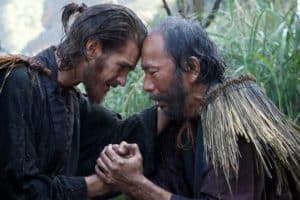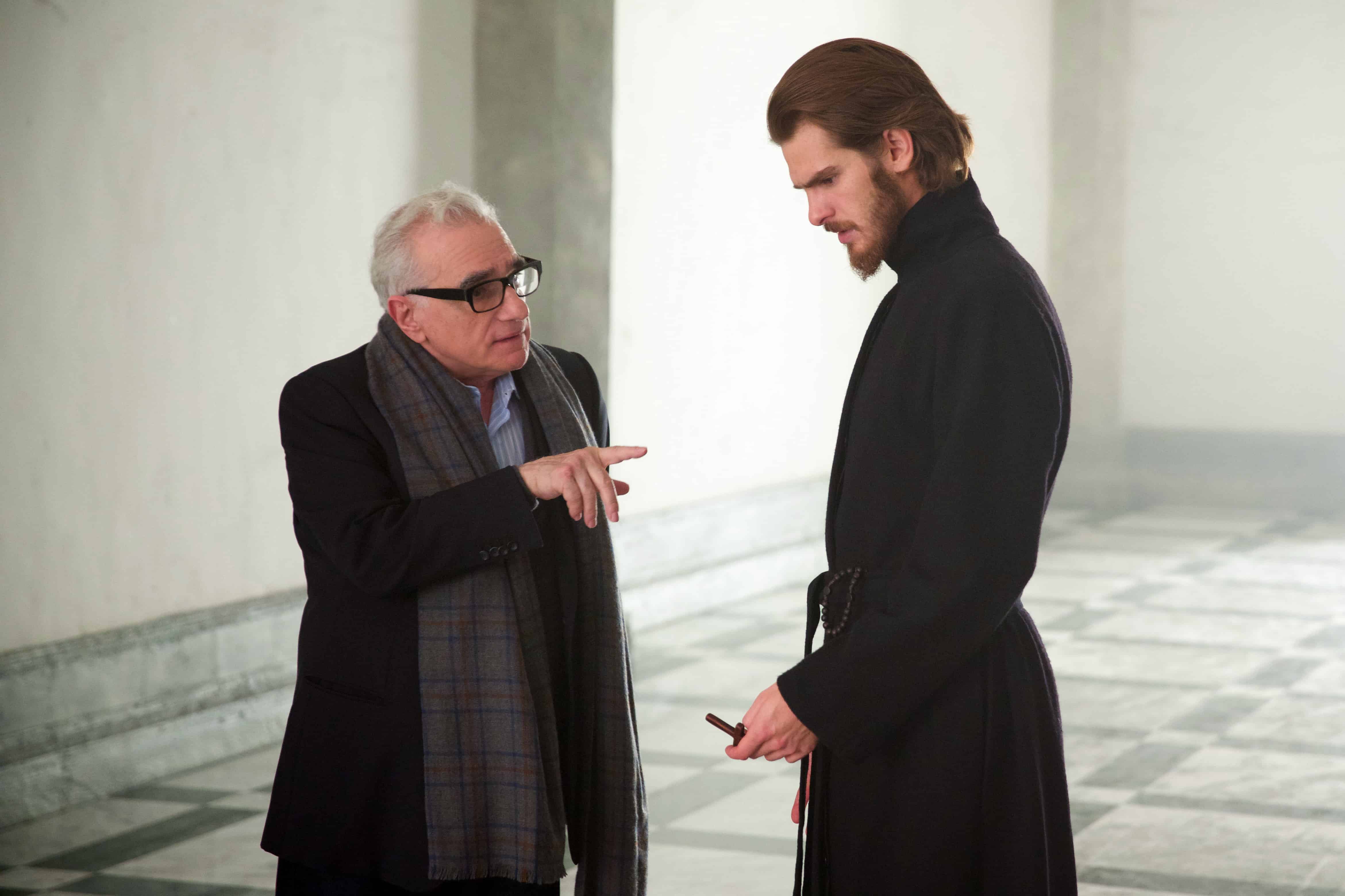James Martin, SJ, editor at large of America Media and author of many books, including Jesus: A Pilgrimage and The Jesuit Guide to (Almost) Everything served as a consultant to Martin Scorsese’s new film “Silence.” In this interview, he speaks in depth with two TJP writers, Brian Strassburger and Dan Dixon, about the process of helping Mr. Scorsese and the actors create a beautiful new film about the Jesuits.
Today we are sharing the second half of the interview. If you missed Part I, click here.
Brian Strassburger (BS) and Dan Dixon (DD): The wait is finally over- “Silence” comes out today, in limited release. Tell us why you would recommend seeing the film.
James Martin (JM): First of all, it’s a magnificent movie. That is, simply as a film, it’s artfully told, perfectly paced, and superbly acted. I’m no film scholar, but I found it visually beautiful–often overwhelmingly so. The scene of the crucifixion in the ocean is just astounding. Second, it raises essential questions about faith, specifically, how does one discern the right thing to do? Third, it recounts an important chapter of church history—the story of the Jesuit Martyrs and the Japanese church, which I think is not well known by the general public or even many Catholics.
The questions that the film raises are also ones of real spirituality, not fake spirituality. So many so-called religious films portray spirituality as follows: Something bad happens, and all you need to do is pray, or find God, and everything is solved. But real spirituality says that even with your belief in God, something bad might happen to you. Then what do you do? To me, “Silence” may have a hard time finding an audience among any moviegoers used to fake spirituality, or “cheap grace” as Dietrich Bonhoeffer called it. “Silence” is about real grace. And that’s sometimes not so easy to accept. On film or in real life.
BS/DD: What elements of Ignatian spirituality are most evident in the film?
JM: Most of all the relationship of the main character, Father Rodrigues, with Jesus. This is paramount. The central theme of the film is Fathers Rodrigues and Garupe trying to discern what Jesus would have them do in such a confusing situation. That’s why that line where Rodrigues says, “We asked for this mission” is critical. I felt the line meant not only the mission to find Father Ferreira, their mentor, but the mission that comes with the Spiritual Exercises. Specificaly, where the Jesuit asks to be placed with Christ. That is, “I asked for this in the Exercises. I asked to be placed with your Son.” That’s the larger mission that they asked for.
But the spirit of the Exercises suffuses the entire film. Rodrigues is fascinated by the person of Jesus, and consistently speaks to him in prayer, “as one friend speaks to another,” as the Exercises say. And Garupe tries to discern the right path for himself and for the Japanese Christians, and then is willing to die for them, as Christ died for humanity. Even Ferreira seems to struggle with his relationship with God, though less overtly.
And one of the most moving lines for me is a quote that I suggested from the Exercises, from the Colloquy with Christ on the Cross, “What have I done for Christ? What am I doing for Christ? And what ought I do for Christ?” I suggested to Marty and Jay 1 that this is precisely what a Jesuit would be thinking in a situation like this. And it really moved me to hear Andrew 2 say it. Andrew had prayed about it, as all retreatants do, when he made the Exercises, and then said it onscreen, and now people who may know nothing about the Jesuits can ask themselves that life-altering question.
BS/DD: You mentioned the experience of leading Garfield (a non-Christian) through the Exercises. He has spoken publicly about how he has developed a personal relationship with Jesus as result of that experience. Can you elaborate on the how he came to be interested in making the Exercises?
JM: Without breaking any confidences, I can say this: Andrew was intent on learning everything he could about the Jesuits. So, after a few conversations he asked, naturally, about the Spiritual Exercises. Anyone who reads anything about the Jesuits will eventually be curious about the Exercises. But I balked, since he hadn’t had much experience with what you’d call formal prayer. It’s like asking someone to do a marathon when they’re still just sprinting.
So instead I asked him to start doing the daily examen. He did, to great effect. He continued to ask about the Exercises, and I continued to put him off, and then I figured that I could at least give him a few introductory meditations from the First Week. I did, and suddenly we were in the Exercises. And it took me aback. I really had to pray about it and talk to my own spiritual director, but it seemed obvious that—despite my doubts—God was intent on drawing him into the Exercises. It was pretty amazing, frankly.
We did the 19th Annotation retreat over the course of several months. Usually we met every week at America House, but occasionally it was over Skype if one of us was traveling. At one point Andrew and Adam had to go to Portugal for some research. Andrew was just about to enter the Third Week, which focuses on the Passion and Death of Christ, and we both realized that taking a pause in the Exercises would not be a good idea- especially at this point. So I arranged for him to spend time at St. Beuno’s, a Jesuit retreat house in Wales. So, he did the Third Week over the course of one week, much as you would do it in a Thirty-Day retreat, with several meditations a day, and we Skyped every night. For his part, Adam also made a five-day retreat at St. Beuno’s. After that, Andrew and I returned to the normal week-to-week pattern of the 19th Annotation.
Believe it or not, Andrew completed the Exercises the day before he was to leave for Taiwan. I felt that it would be a good idea to mark the end of the process, and wanted him to feel the support of the Society, so I asked John Cecero, SJ, my Provincial, if I could somehow “mission” him to do the part. I didn’t even know if you could do something like that, frankly, but I figured it would really mean something to Andrew, so why not ask? He said yes, so I told Andrew that the Provincial was missioning him to do this, which he was, and I gave him a little cross that my novice director had given me for my Long Experiment. It was pretty moving for both of us.
BS/DD: Is this your first experience leading a non-Christian through the Exercises? How is it similar and how is it different than leading a Christian through the Exercises? What do you think it is about the Exercises that can hold appeal and make an impact even in the life of a non-believer?
JM: Yes, it was my first experience of that sort. Frankly, if you had asked me before this experience if a non-Christian without much experience in formal prayer could do the Exercises, I would say, “Absolutely not.” But, again without any breaking of confidences, what happened, which surprised me, is that God very quickly drew this young man into the Exercises and invited him into a sincere relationship with Jesus. There were differences in terms of directing a more traditional retreatant, of course, particularly in terms of familiarity with certain Gospel passages. But the Exercises are a work of genius. They work.
Of course, the person needs to be open to the reality of Jesus, fully human and fully divine, but all God needs, I discovered, is openness.
Andrew did the Exercises as fully and generously as anyone I’ve ever directed. As any Jesuit. By the end, he knew as much about Jesuit spirituality as anyone who had completed the Exercises–as much as any first-year Jesuit novice 3. In fact, he could then read the script with new eyes, and say, “Oh a Jesuit wouldn’t say this, would he?” Before they all left the States, in fact, Marty said to me, “I’m sorry you won’t be coming to Taiwan. We’ll miss not having an expert in Jesuit spirituality.” And I said, “You will have one: Andrew. He’s just finished the Exercises.”
BS/DD: The story grapples with challenging topics of faith, including martyrdom and apostasy. How will a movie-goer feel after walking out of the film?
JM: That depends on where the moviegoer is with his or her spiritual life. Nonbelievers may find this movie difficult, if not downright confusing, though I think that they will be able to enter into Father Rodrigues’ dilemma. On the other hand, they might think “Why are they even there?” Or “Why doesn’t he just apostatize right away?” So the nonbeliever might walk out of the film saying, “I don’t get it.”
But the believer, especially the Christian and the Catholic, will be profoundly affected. It’s one of the greatest movies on the Christian faith ever made. I think the viewer will feel the need to ponder it, discuss it, and pray about it afterwards. It will stay with you, believe me.
BS/DD: My Jesuit classmate intentionally avoided this book during his novitiate because of its dark nature and heavy themes. Does the movie leave you in despair? Or can the viewer find hope and encouragement in their faith?
[WARNING: Spoiler alerts ahead. Skip to the next question if you want to avoid these.]

L-R: Andrew Garfield plays Father Rodrigues and Shinya Tsukamoto plays Mokichi in the film SILENCE by Paramount Pictures, SharpSword Films, and AI Films
JM: I confess that I found the novel very dark. And I’ve always felt that the ending was maddeningly vague. Without giving away the ending, though, the movie is much less dark. Scorsese has said that Shusako Endo intended Rodrigues to have held onto the faith, and the screenwriters have come up with a magnificent ending that symbolizes that beautifully. Maybe this is heretical to literary types, but I think the film is better than the book. Clearer. In the end the film is about how people fulfilled their vows to God. And really, in terms of Rodrigues, it is about how one Jesuit held onto his faith in the midst of unbelievable pressure.
Interestingly, it raises a specific question about what St. Ignatius called the “Third Degree of Humility.” Can you do something that will earn you contempt if it is the right thing to do? If Jesus asks you to do it? At the film’s climax, Father Rodrigues finds himself called to do something that all of Christian Europe, perhaps even his Jesuit superiors, would find contemptible. Even sinful. But because Jesus asks him to do it, because it is what it means to stand with Jesus, the Jesus he met in the Exercises, he does it. It’s an extremely subtle depiction of the Third Degree of Humility, it seems to me. And, by the way, Andrew grasped that immediately, after being introduced to the Third Degree of Humility.
BS/DD: You have described the film as “like a prayer.” How has the experience of working on this film impacted your own prayer life?
JM: For one thing, it clarified the Third Degree of Humility, as I just mentioned. And it illustrated the lengths to which the Jesuit missionaries went. There’s a scene where Father Rodrigues runs up onto the beach; it’s a long shot, and he’s utterly alone. And I thought, I can’t believe what the Jesuit martyrs went through. Ironically, when I saw that scene I thought of the North American Martyrs, who ministered around the same time period in what is now New York and Canada. I always think of St. Isaac Jogues and his companions in their cassocks trudging through the snow in upstate New York. The faith they had to do this, thousands of miles from all they knew, is just astonishing to me.
All that I brought to prayer. And I was edified by Rodrigues, which is so strange to say since he’s a fictional Jesuit. But my reaction to the film also comes from being inspired by the martyrs, which I have been since I was a novice.
And yes, it did feel like a prayer to me. Like a “composition of place,” as Ignatius would say about imagining yourself in a certain Gospel scene. In this movie, Scorsese has “composed a place” for us, allowing us to enter into the story of the Jesuit missionaries and the Japanese Christians.
BS/DD: After accompanying the cast and crew over the past few years, tell us about your experience of first watching the film.
JM: I’m not embarrassed to say that I wept. It was overwhelming. And it took me a while to unpack it all in prayer. First, it was just a beautiful movie, as I said. Second, it was the story of the Jesuit martyrs of Japan- my brothers- and that itself was overwhelming. As I’ve said, I have a great devotion to the Jesuit martyrs from any era. Third, it was powerful seeing the actors onscreen- especially Andrew, knowing what he had gone through in the Exercises. Fourth, it was a bit overwhelming to see certain bits of dialogue that I had suggested to the screenwriters. I had a hard time just taking that in, and I don’t even know if I can describe that emotion. Finally it’s a story of one person’s faith, and his relationship with Jesus, and the ending shattered me.
And then maybe there was some relief that the film was as beautiful as it was. I had only a very small part in it, but I really wanted it to be done right, to really be Jesuit, to do the Jesuits justice. I think all the Jesuits who helped out on the film felt the same way. So there was relief and gratitude that it was such a magnificent work of art. But it was so emotional that I don’t know if I can watch it again. At least not soon. But I hope that everyone else does.
BS/DD: Thank you so much, Jim, for taking time to answer our questions and sharing with us in detail about your experience. It definitely sounds like “Silence” is a can’t-miss movie. We didn’t think it was possible, but you have left us even more excited for its release!
Editor’s Note: Check out “Silence” in limited release on December 23 and expanding in early January 2017. And don’t forget to read Part I of the interview if you missed it.
- Refers to director Martin Scorsese and screenwriter Jay Cocks ↩
- Refers to lead actor Andrew Garfield, who portrays Fr. Rodrigues ↩
- Editor’s Note: The Spiritual Exercises are completed by every Jesuit, usually two times in their entirety. The first time is during a Jesuit’s first or second year of formation, which is called the “novitiate.” ↩


